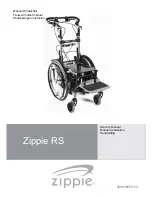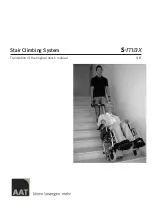
1.2.4. chair Back
The chair back features an adjustable shoulder support. By loosen-
ing the two hand screws, it is possible to tilt the shoulder support
forwards or backwards. To raise the chair back, loosen the two
bolts on the telescopic tube which is visible when the shoulder
support is folded back. The height of the chair back can now be
adjusted and increased by up to 10 cm.
Depending on how the powerchair is equipped, it may have: fixed
back tilt, manual back tilt or electric back tilt.
The fixed back tilt can be regulated (using tools) by adjusting the
tilt pole behind the chair back. The pole can be released from the
ball shaft at one end and either extended or shortened by turning
the ends in the middle piece. The manual back tilt can be adjusted
using the gas spring handle (push down) while pushing the chair
back into the desired position. Release the handle to secure the
chair back again.
The electric chair tilt can be operated from the tilt switch (normally
located on the same side as the control box).
1.2.5. neck sUpport
The height and position of the neck support (optional) are adjust-
able. By loosening both hand screws, the neck support can be
positioned as desired.
note!
If you need to raise the neck support, it is possible to raise
the shoulder support, see above.
3.0. maintenance
3.0.1. Batteries
The VELA Blues 200 is equipped with two 34 Ah maintenance-
free and vapour-free batteries. Good-quality new batteries provide
the equivalent of an operating range of 18 km. Experience shows
that this covers the daily needs of most users. The batteries are
dimensioned to be fully run down 220 times. Their lifetime will be
extended significantly if they are only partially run down before
charging. Defective batteries must be replaced with batteries of the
same type. We recommend that batteries be replaced by a service
technician.
note!
When installing batteries, extreme care must be taken to
c/- correctly. Red wire to the + pole. Incorrect connection
can damage the powerchair’s electronics.
note!
Batteries must not be disposed of with ordinary household
rubbish. Used batteries and other electrical equipment must be
deposited at an approved recycling centre according to the marking
on the product.
3.1. charging
3.1.1. Battery indicator
The control box has a built-in battery indicator. For fully charged
batteries, three groups of coloured LEDs light up. During use, the
voltage in the batteries falls, and the row of lights decreases: The
lights go off one at a time.
• Green signal = DRIVE
• Yellow signal = Recharging needed soon
• Red signal = Recharging needed immediately
The battery indicator will flash to call attention to low battery
power.
8
17








































